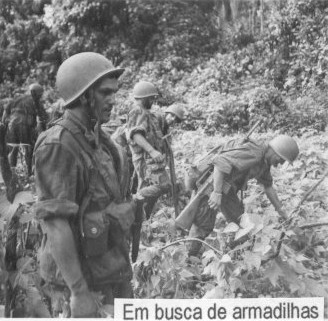The Mozambican War of Independence (1964-1974)

Portuguese soldiers on patrol. (Public Domain photo. Info can be found here)
The fighting in Mozambique was one of many of the Portuguese colonial wars. The Mozambique Liberation Front (FRELIMO) sent their rebels to other countries in an effort to train their troops for a later attack. Once the fighting started this became a Cold War battlefield, where the USSR and Cuba showed up to try to influence a move towards communism. Due to the fact that FRELIMO only had 7,000 trained troops to match up against 23,000 Portuguese troops, they had no option other than to use guerrilla warfare as their strategy. The Portuguese spent a good deal of money trying to build infrastructure (roads, railways and bridges) in the country so that it was easier to move their men. Both sides of this battle used tough tactics, with assassinations and murder being the norm. The civilians ended up being stuck in the crossfire of this battle because the rebels would kill those who were loyal to Portugal and the Portuguese would kill those suspected of aiding the rebels. The worst of this was usually when the Portuguese used helicopters to shoot at rebel areas due to the fact that they often missed and killed innocent civilians. As the violence increased on both sides the locals started to dislike the Portuguese soldiers more and more. This caused the army to start paying African mercenaries instead of using their own troops to keep this feeling from spreading. The reality of this battle was that the majority of the deaths (66%) happened to people who stepped on landmines that had been laid.
Like other Portuguese lands, the war would end due to the Carnation Revolution in Portugal. In this case
the Portuguese handed over power to the FRELIMO in what was called the Lusaka Agreement (1974). While this make most of the population happy, it also lead
to a good deal of economic problems that hurt the leaders enough that the instability led to civil war. Issues that the people had with the early leadership of FRELIMO would lead to the Mozambican Civil War (1977-2002) where the government fought a resistance movement called RENAMO. This rebel group was funded by Rhodesia and South Africa, but would be extremely unliked by the rest of the international community for attacking civilian populations and the use of child soldiers. The FRELIMO government would eventually be forced to give free and open elections (1994) because they couldn’t keep up with the amount of money the Russians were spending to hurt them. In the end, the war would cost the lives of nearly 1 million people, largely due to starvation. Another 5 million people were displaced from their homes during this conflict.

The location of Mozambique. (Public Domain photo. Info can be found here)
